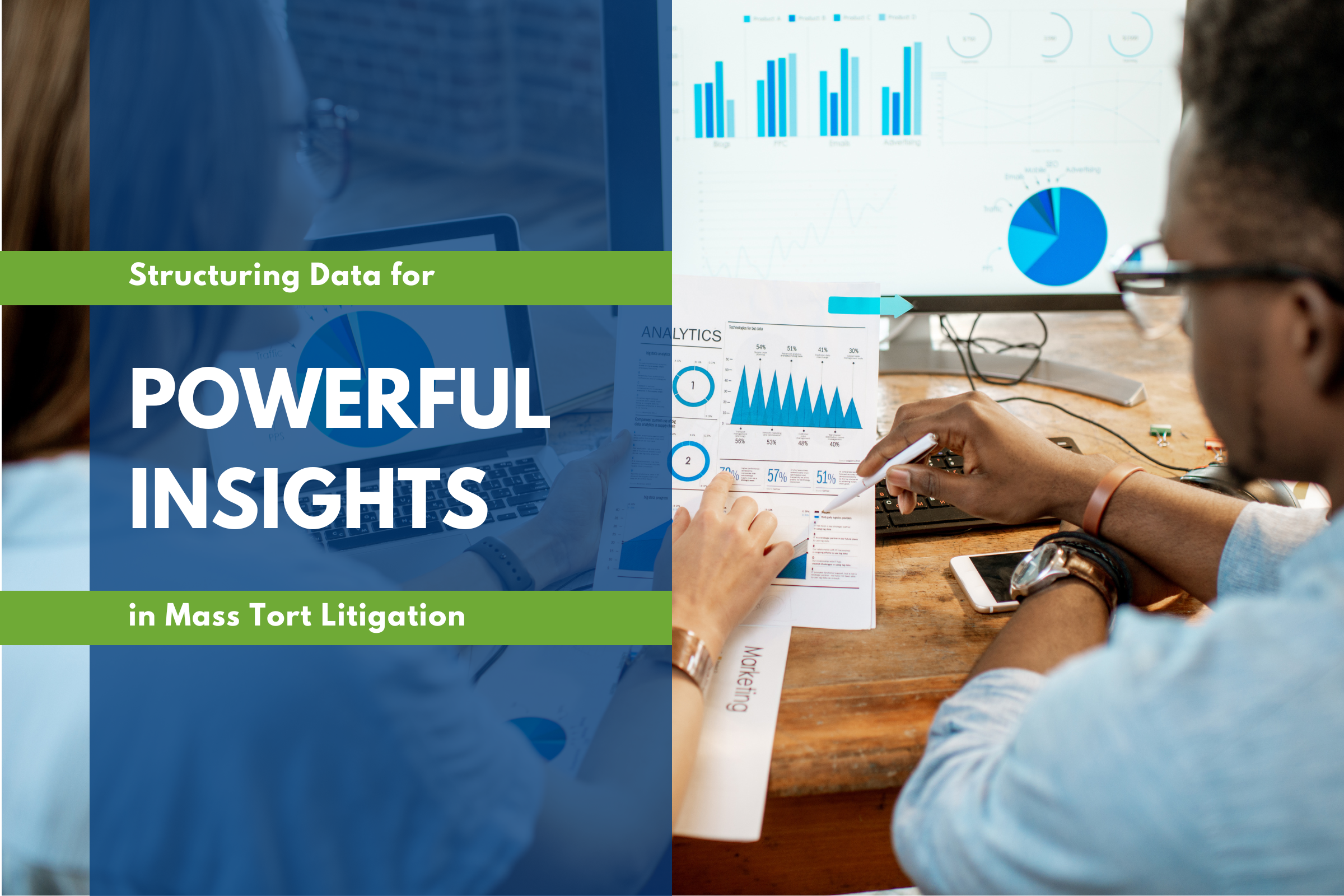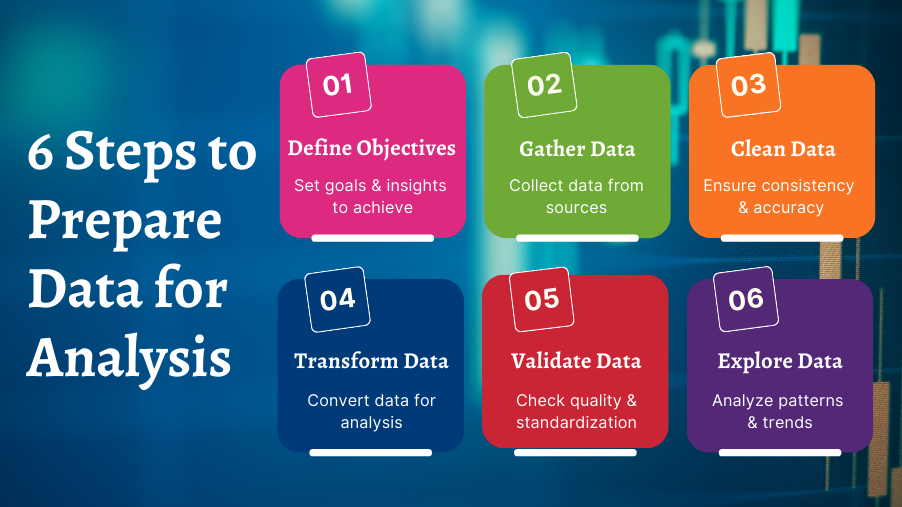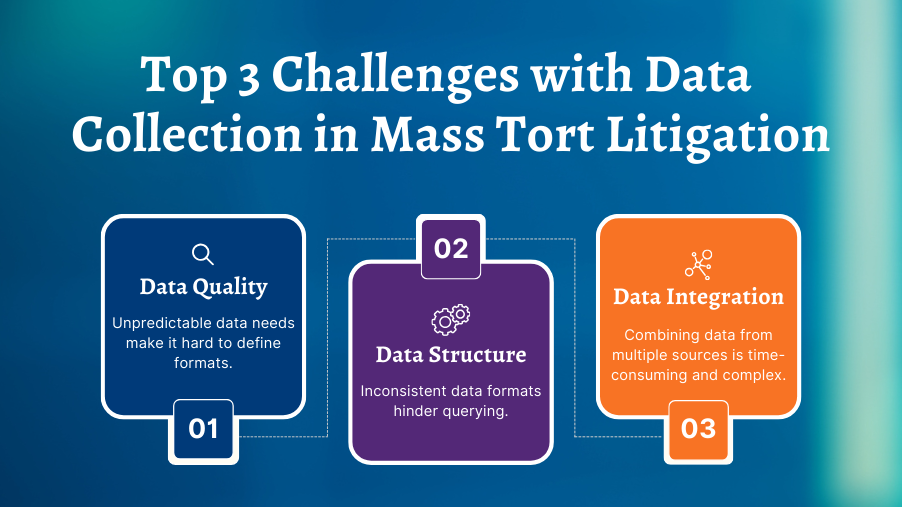
In mass tort litigation, the sheer volume and complexity of plaintiff data can quickly overwhelm legal teams, hindering their ability to derive actionable insights. However, with effective data structuring strategies, law firms can turn this information into powerful reports that guide case strategy and decision-making.
Whether managing hundreds or thousands of claimants, properly structuring your data is essential to maximizing the value of your data collection efforts.
What is Data in Litigation?
During the discovery process, different evidence is collected to substantiate or defend against a claim. This information can include the person or business filing the complaint, the person or business whose complaint is being filed, the allegations at issue, potential fact witnesses, and more.
Discovery requests can be made through subpoenas, interrogatories, discovery questionnaires, or requests to produce documents or data. The data itself can include:
• Emails
• Business records
• Mobile phone usage
• Messaging data
• Social media content
• Medical records
• Employment records
• and more
How is Data Collected in Mass Tort Litigation?
In many mass tort cases, data about specific plaintiffs and defendants is gathered by a tool referred to as a fact sheet or profile form. These include a set of interrogatories or a discovery questionnaire, that is uniform and completed by all the plaintiffs to determine the basis for their specific claims.
Historically, these forms were completed individually by plaintiffs or their legal representatives and gathered in hard copy format, or sometimes in electronic format, such as a fillable PDF. In recent years, parties have the option to utilize a centralized data platform to collect, exchange, and share data.
Data Collection: Fillable PDFs vs Legal Tech Platforms
Data Types for Plaintiffs
• General demographics
• Medical background
• Proof of use or exposure to a product or a substance
• Proof of the injury that's being alleged
Fillable PDF
A fillable PDF is a form, completed electronically, and can include tools to help structure the data such as checkboxes and drop-down lists. The challenge with using PDFs is ingesting the data from potentially hundreds or thousands of individual forms in a manner that is going to most effectively allow for reporting and analytics.
Centralized Data Platforms
Centralized data platforms are designed to ensure consistency and standardization across all forms and to process and analyze data. They are intended to provide analytics and dashboards as the end goal. Law firms, both plaintiff and defense, can identify trends and patterns within the data and better understand relationships that they may not have even previously considered. These platforms can also be designed to accommodate the changing needs of the parties as litigation evolves while providing a more secure avenue for collecting private and confidential data.
Data Intake Platforms: Transferring Data from a Spreadsheet to a Tech Platform
There are ways to transfer data from a spreadsheet to another system or program, but advanced preparation is key. The spreadsheet must align with the ingesting system formatting and overall structure for favorable outcomes. Typically, there is a process involved to map which spreadsheet fields go with which database fields.
Some drawbacks may be experienced throughout this process such as corrupt data when trying to convert formats from a spreadsheet that do not align with the ingesting platform, or timeout errors if a small special character is used and is not recognized.
For large datasets, it is a common best practice to use a pre-made spreadsheet template with locked field and formats for bulk to reduce data entry errors.
Data Modeling vs. Data Normalization
Data modeling and data normalization refers to the processes that occur once the data is received. These terms are used somewhat interchangeably, but there are distinct differences.
Data modeling is a process of analyzing and defining various types of data being collected, stored, and used. It involves creating a visual representation of an information system to better communicate trends and relationships between data points.
To do this, data needs to be defined and structured in a way that maximizes desired outcomes. The basics involve logically structuring the data, defining the relationships, and establishing how different data elements interact with one another.
Data normalization is the organization of the data to ensure similarity and consistency across all records, systems, and fields. The goal is to ensure that the data is logically stored, easy to find or retrieve, and improve overall data integrity, allowing for more usable and reliable data.
6 Steps to Prepare Data for Analysis

Preparing data for analysis is a crucial step in transforming raw information into actionable insights that drive meaningful outcomes.
- Define the objectives and requirements. Example areas to define include:
- What are the end goals?
- What are you trying to achieve with the data and any potential associated insights?
- What do you want to learn?
- What do you want to identify?
- What kind of reports or metrics might you be seeking?
- Gather the data. This could be through a mass export of a company's database or system, or from discovery questionnaires like fact sheets and profile forms.
- Clean the data. This is a very critical step. Data must be consistent, available, and accurate through data normalization and data modeling.
- How will missing values be treated?
- Are there data fields that are going to be required versus optional ones?
- Are there ways to reduce duplicates including duplicate data fields and duplicate respondents?
- How will errors or exceptions be handled or corrected?
- Transform the data. The data is now converted and structured into a usable format to best support analytics and general decision-making.
- This could involve preparing the data to match a specific system.
- It could be making modifications to fit a particular purpose or context.
- Validate the data. Data is checked for quality and accuracy before it is used, imported, or processed. Data formatting is assessed according to preset rules. This step ensures maximized standardization.
- Explore the data. This is the step where analysis begins. It involves using data visualization tools to identify similarities, trends, patterns, and maybe even outliers. This is when data analysts can begin identifying the potential relationships between data sets and variables.
Top 3 Challenges with Data Collection in Mass Tort Litigation

- Data quality. In litigation, when parties initially contemplate what data to gather, it is difficult to know what format is going to be best later in the process when it is time to query or use the data. The information needed as litigation evolves can change significantly, which makes it hard to predict.
- Data structure. This refers to how the data is being formatted when it's initially captured. For example, using free text fields can present challenges later in the process if parties wish to query a database. It will be challenging to identify all the instances of the free text field because every respondent will denote differently in their respective discovery questionnaires. Using option sets, checkboxes, or radio buttons ensures consistent responses across all plaintiffs, making it easier to identify and report on the data.
- Data integration. There can be many complexities that arise when combining data sets from multiple sources. For example, if a matter involves multiple plaintiff law firms, each may have a different intake platform they are using to gather data. Firms typically don’t have the bandwidth to rekey the data into another system when it’s time to respond to a discovery questionnaire. The preferable option for them would be to export the data they have from their intake system and set it up in a way that it can be ingested into the centralized data platform that manages the actual discovery questionnaire process. If every firm's intake system is set up differently with different dropdowns or checkbox fields and values, all the data needs to become consistent before a new system can fully recognize it. This is the stage where data cleaning and normalization take place. This can be a challenging and time-consuming process.
Benefits of Utilizing Legal Tech to Manage Data
Fact sheet completion is increasingly being done through an online centralized data platform, enabling consistent data capture and leading to improved metrics, reporting, and insights.
Some law firms may not have the infrastructure required to manage data collection in large-scale mass tort litigation. Legal tech partners specialize in data capturing, data processing, data management, and how to get the best insight from litigation data. They will have tools that help ensure data integrity and robust analytical tools and dashboards.
These partners can help at the outset with advanced planning and work with legal teams to get maximum value from the data as that litigation evolves to trial or resolution. They can bring peace of mind to ensure the data remains secure and is accessible at the right times to the right parties throughout the litigation.
How can LMI help manage complex mass tort litigation
LMI has 40 years of extensive experience in injury-related multidistrict litigations, managing complex data and all medical aspects of discovery. Our team of legal professionals and data analysts can work with all parties to develop questionnaires and fact sheets to meet the specific requirements of the case which can yield powerful analytics early in the process.
Contact us today.
Podcast: Leverage mass tort data with strategies for better reporting and insights.
Join Megan Pizor, LMI’s General Counsel and Chief Data Officer, and Angela Browning, LMI’s Chief Strategy Officer, distinguished legal professionals with extensive experience in mass tort litigation, as they dive deep into the science behind data modeling and best practices for data collection and management to get to the root of allegations at the outset of litigation.